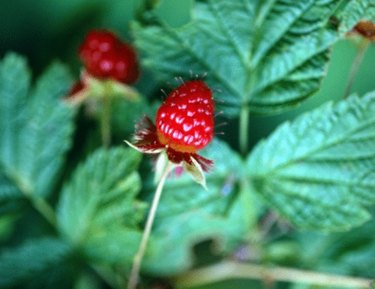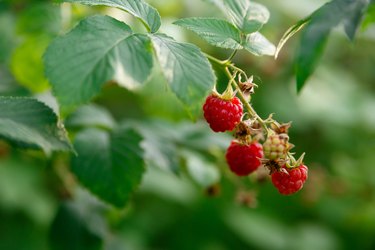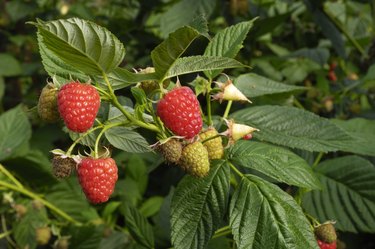
Raspberries are the one of the most popular small fruits for fresh eating. The berries from these easy-to-grow plants are also excellent in jams, preserves, jellies, pies, tarts and other treats, bringing the freshness of summer to the table all year long. Raspberries are also fairly adaptable and grow well under a range of climatic conditions; for example, while most small fruits need at least eight hours of full sun each day, many raspberries do well with less, flourishing in partial shade or dappled light.
Growing Raspberry Bushes
Video of the Day
The roots of the raspberry bush are perennial, but the canes themselves are biennial, living for just two years. New stems, or first-year canes, are known as primocanes. They increase the size of the shrub and provide the plant with valuable, energy-generating foliage, but, for the most part they produce no fruits.
Video of the Day
Second-year canes, or floricanes, bear abundant clusters of sweet fruit. Though there are some ever-bearing brambles that produce a handful of berries on the tips of first-year canes, the standard bramble is summer-bearing, producing fruit during the summer on the second-year canes only.
Choosing Raspberry Planting Sites

The most appropriate site for a new raspberry bush depends on both the local climate and the type of berry being grown. The sweet, aromatic fruits of the raspberry bush are available in a variety of jewel-tone colors. For the most part, red and yellow berries are the most cold-hardy, but they require at least six hours of direct sunlight to be fully productive; black and purple berries are more tolerant of both heat and shade, but may perish if exposed to extremely cold weather.
While the sun exposure at the top of a hill is usually excellent, peaks and crests are not good locations for raspberry bushes. Hilltop planting leaves the stems exposed to the full force of the prevailing winds, which can dry the fruits or knock them to the ground.
Supporting and Controlling Raspberry Bushes
Each raspberry plant base is capable of producing multiple new stems each spring. These thorny canes can grow wildly out of control if they are not reigned in. To keep raspberry brambles under control, install a trellis near the base of the plant; as the shrub grows, allow the new primocanes to flow freely around the base of the plant and tie second-year floricanes to the trellis. This method elevates the fruit-bearing branches above the primocanes, offering the ripening berries greater exposure to the sun.
Pruning Raspberry Canes

Pruning raspberry bushes keeps the garden tidy and removes barren branches, allowing more sunlight and air to reach the fruitful portions of the plant. After fruiting, the floricanes begin to wither and should be pruned down to the ground. This step directs more energy into the growth of the roots and the development of the remaining primocanes. Additionally, winter damage should be removed from raspberry bushes early in the spring, before the new canes begin to grow.
Tip
Some raspberry cultivars are hypersensitive to extreme heat, especially during periods of low humidity. If your berries appear to show signs of sunburn, cover the developing fruits with shade cloth during the hottest hours of the day.